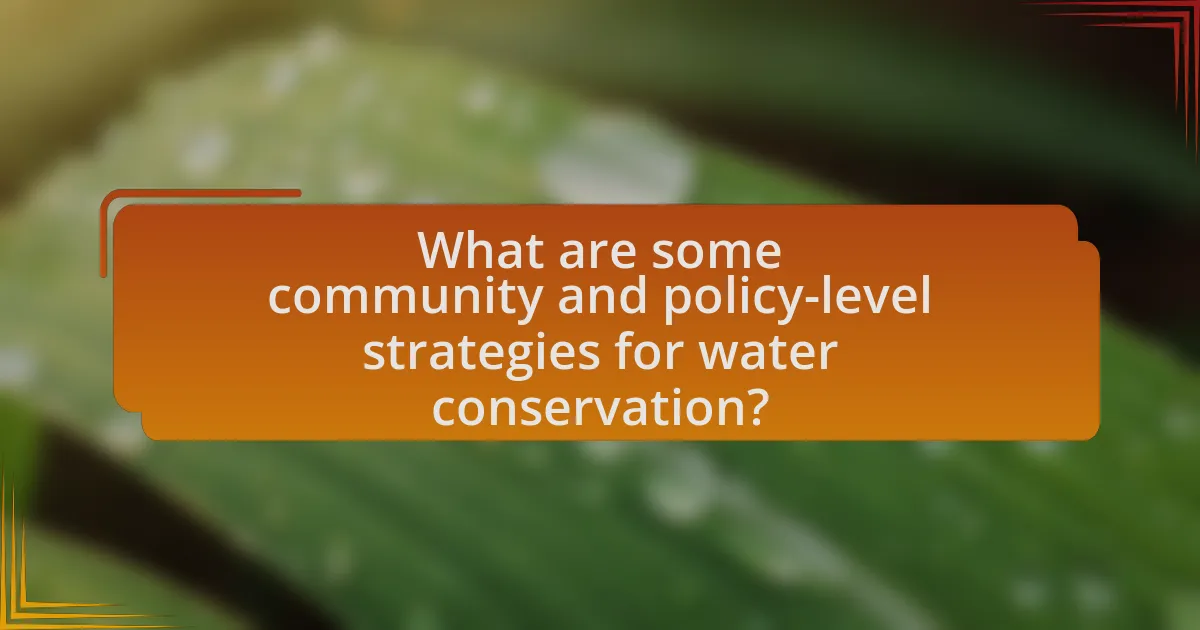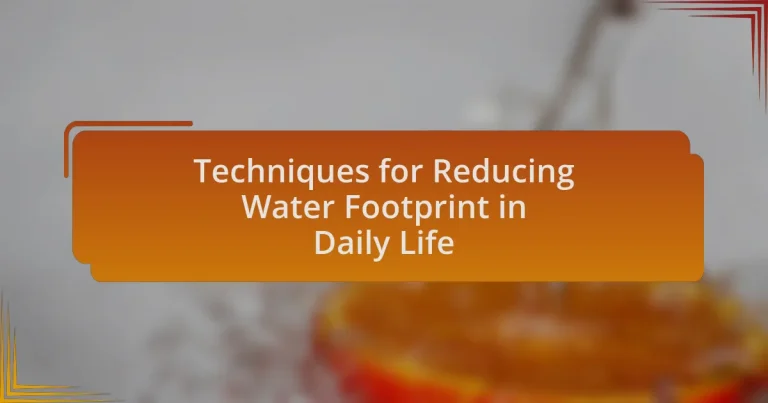The article focuses on techniques for reducing water footprint in daily life, emphasizing the importance of water conservation for environmental sustainability. It outlines practical methods such as adopting water-efficient appliances, mindful consumption, and sustainable gardening practices. Additionally, it discusses how individuals can assess their water usage, identify major sources of consumption, and implement lifestyle changes to minimize water waste. The article also highlights community and policy-level strategies that support water conservation efforts, providing a comprehensive overview of actions that can be taken at both individual and collective levels to address water scarcity issues.
What are the Techniques for Reducing Water Footprint in Daily Life?

Techniques for reducing water footprint in daily life include adopting water-efficient appliances, practicing mindful consumption, and implementing sustainable gardening practices. Using water-saving fixtures like low-flow showerheads and dual-flush toilets can significantly decrease household water usage. Mindful consumption involves reducing meat intake, as livestock farming requires substantial water resources; for instance, producing one kilogram of beef can consume over 15,000 liters of water. Sustainable gardening practices, such as xeriscaping and rainwater harvesting, can also minimize water usage while maintaining healthy landscapes. These methods collectively contribute to a lower water footprint and promote environmental sustainability.
How can individuals assess their current water usage?
Individuals can assess their current water usage by reviewing their water bills, which typically provide monthly consumption data in gallons or liters. This method allows individuals to track their usage over time and identify patterns or spikes in consumption. Additionally, using water usage calculators available online can help estimate daily water use based on household activities, such as showering, washing dishes, and laundry. According to the U.S. Environmental Protection Agency, the average American household uses about 300 gallons of water per day, highlighting the importance of monitoring and managing water consumption effectively.
What tools are available for measuring water consumption?
Various tools are available for measuring water consumption, including water meters, flow sensors, and smart irrigation systems. Water meters are commonly installed in homes and businesses to track total water usage, providing accurate readings of consumption over time. Flow sensors can be attached to plumbing fixtures to monitor real-time water flow, allowing users to identify leaks or excessive usage. Smart irrigation systems utilize weather data and soil moisture sensors to optimize watering schedules, reducing unnecessary water use in landscaping. These tools collectively help individuals and organizations monitor and manage their water consumption effectively.
How can one identify the biggest sources of water usage at home?
To identify the biggest sources of water usage at home, one can conduct a water audit, which involves tracking water consumption in various household activities. This process typically includes reviewing water bills to determine overall usage, using water flow meters to measure the output from faucets, showers, and appliances, and assessing the frequency and duration of water use in activities such as laundry, dishwashing, and gardening. According to the U.S. Environmental Protection Agency, indoor water use accounts for about 70% of total household water consumption, with toilets, showers, and faucets being the primary contributors. By systematically analyzing these areas, homeowners can pinpoint where the most water is being used and take steps to reduce consumption.
Why is it important to reduce water footprint?
Reducing water footprint is important because it conserves freshwater resources, which are limited and essential for human survival and ecosystem health. The global population is projected to reach nearly 10 billion by 2050, increasing the demand for water. According to the United Nations, water scarcity affects more than 2 billion people worldwide, highlighting the urgency of sustainable water management practices. By minimizing water usage in daily activities, individuals can contribute to preserving this vital resource, ensuring its availability for future generations and maintaining ecological balance.
What environmental impacts are associated with high water usage?
High water usage leads to significant environmental impacts, including depletion of freshwater resources, disruption of aquatic ecosystems, and increased energy consumption for water treatment and distribution. The over-extraction of water from rivers and aquifers can result in reduced water levels, harming fish populations and other wildlife dependent on these habitats. For instance, the World Wildlife Fund reports that over 2 billion people live in water-stressed areas, highlighting the urgency of addressing high water consumption. Additionally, the energy required to pump, treat, and heat water contributes to greenhouse gas emissions, exacerbating climate change. Thus, high water usage not only strains natural resources but also has broader implications for environmental sustainability.
How does reducing water footprint contribute to sustainability?
Reducing water footprint contributes to sustainability by minimizing the overall consumption of freshwater resources, which helps preserve ecosystems and maintain biodiversity. When individuals and organizations lower their water usage, they decrease the demand on water supplies, leading to less stress on rivers, lakes, and aquifers. This reduction can result in improved water quality and availability for future generations, as well as enhanced resilience against climate change impacts. For instance, the World Resources Institute reports that sustainable water management practices can lead to a 30% reduction in water use in agriculture, which is the largest consumer of freshwater globally.
What practical techniques can be implemented in daily routines?

Practical techniques that can be implemented in daily routines to reduce water footprint include adopting water-efficient appliances, practicing mindful water usage, and implementing rainwater harvesting systems. Water-efficient appliances, such as low-flow showerheads and dual-flush toilets, can significantly decrease water consumption; for instance, low-flow showerheads can save up to 2.5 gallons of water per minute. Mindful water usage involves simple actions like turning off the tap while brushing teeth or fixing leaks promptly, which can collectively save hundreds of gallons annually. Additionally, rainwater harvesting systems can capture and store rainwater for irrigation and other non-potable uses, further minimizing reliance on municipal water sources.
How can water-saving fixtures and appliances help?
Water-saving fixtures and appliances help by significantly reducing water consumption in households. These devices, such as low-flow showerheads, dual-flush toilets, and energy-efficient dishwashers, can decrease water usage by up to 50% compared to standard models. For instance, the U.S. Environmental Protection Agency (EPA) states that replacing older toilets with WaterSense-labeled models can save an average of 13,000 gallons of water per year per household. This reduction not only conserves a vital resource but also lowers water bills, making it economically beneficial for consumers.
What types of water-efficient fixtures are available for homes?
Water-efficient fixtures available for homes include low-flow faucets, low-flow showerheads, dual-flush toilets, and water-efficient appliances such as dishwashers and washing machines. These fixtures are designed to reduce water consumption without sacrificing performance. For instance, low-flow faucets can use 1.5 gallons per minute compared to standard faucets that use 2.2 gallons per minute, leading to significant water savings. Similarly, dual-flush toilets allow users to choose between a lower volume flush for liquid waste and a higher volume flush for solid waste, which can save up to 67% more water per flush compared to traditional toilets.
How do appliances like dishwashers and washing machines affect water usage?
Appliances like dishwashers and washing machines significantly reduce water usage compared to hand washing and manual laundry methods. For instance, modern dishwashers use approximately 3 to 5 gallons of water per cycle, while hand washing can consume up to 27 gallons. Similarly, high-efficiency washing machines use about 15 gallons per load, compared to older models that may use 40 gallons or more. These appliances are designed to optimize water efficiency, often incorporating features such as sensors that adjust water levels based on load size, thereby minimizing waste.
What lifestyle changes can lead to reduced water consumption?
Adopting specific lifestyle changes can significantly reduce water consumption. Implementing practices such as fixing leaks, using water-efficient appliances, and reducing shower time can lead to substantial savings. For instance, fixing a leaking faucet can save approximately 3,000 gallons of water per year, while installing low-flow showerheads can reduce water usage by up to 50%. Additionally, choosing drought-resistant plants for landscaping can minimize outdoor water needs. These changes not only conserve water but also contribute to lower utility bills and environmental sustainability.
How can changing shower habits save water?
Changing shower habits can save water by reducing the duration of showers and using water-efficient showerheads. Shortening showers to five minutes can save up to 12.5 gallons of water per person per shower, based on an average flow rate of 2.5 gallons per minute. Additionally, installing low-flow showerheads can decrease water usage by 30-50%, further contributing to water conservation efforts. These adjustments not only lower water consumption but also reduce energy usage associated with heating water, making them effective techniques for reducing one’s overall water footprint.
What are some effective practices for outdoor water use?
Effective practices for outdoor water use include implementing drip irrigation systems, utilizing rain barrels, and selecting drought-resistant plants. Drip irrigation delivers water directly to the roots of plants, minimizing evaporation and runoff, which can reduce water usage by up to 50% compared to traditional methods. Rain barrels collect and store rainwater for later use, providing a sustainable water source for gardens and lawns. Additionally, choosing drought-resistant plants can significantly lower water consumption, as these species require less water to thrive, making them ideal for water-efficient landscaping.
What are some community and policy-level strategies for water conservation?

Community and policy-level strategies for water conservation include implementing water-efficient practices, promoting public awareness campaigns, and establishing regulations that encourage sustainable water use. For instance, communities can adopt xeriscaping, which uses drought-resistant plants to reduce irrigation needs, while policies can mandate low-flow fixtures in new constructions to minimize water consumption. Additionally, public education initiatives can inform residents about the importance of water conservation, leading to behavioral changes that collectively reduce water usage. Evidence from the U.S. Environmental Protection Agency indicates that communities that engage in such strategies can achieve significant reductions in water demand, demonstrating the effectiveness of these approaches.
How can community initiatives promote water-saving practices?
Community initiatives can promote water-saving practices by fostering awareness and encouraging collective action among residents. These initiatives often include educational programs that inform community members about the importance of water conservation and practical methods to reduce water usage, such as installing low-flow fixtures or rainwater harvesting systems. For example, a study by the American Water Works Association found that community-led campaigns can lead to a 10-20% reduction in water consumption in participating households. By creating a sense of shared responsibility and providing resources, community initiatives effectively motivate individuals to adopt sustainable water practices.
What role do local governments play in water conservation efforts?
Local governments play a crucial role in water conservation efforts by implementing policies, regulations, and programs aimed at reducing water usage and promoting sustainable practices. They often establish water conservation ordinances that set limits on water use, especially during drought conditions, and provide incentives for residents and businesses to adopt water-saving technologies, such as low-flow fixtures and drought-resistant landscaping. For instance, many local governments offer rebates for installing water-efficient appliances, which can significantly lower household water consumption. Additionally, local governments conduct public education campaigns to raise awareness about the importance of water conservation, helping to foster a culture of sustainability within the community.
How can individuals get involved in community water-saving programs?
Individuals can get involved in community water-saving programs by participating in local initiatives, volunteering for conservation projects, and attending workshops focused on water efficiency. Many communities organize events such as clean-up days, tree planting, and educational sessions that promote sustainable water practices. For example, the EPA reports that community engagement in water conservation can lead to significant reductions in water usage, highlighting the effectiveness of collective action. Additionally, individuals can join local environmental organizations that advocate for water-saving policies and practices, further amplifying their impact.
What policies can support water conservation at a larger scale?
Policies that can support water conservation at a larger scale include implementing tiered water pricing, promoting water-efficient technologies, and enforcing regulations on water usage. Tiered water pricing incentivizes conservation by charging higher rates for excessive use, which has been shown to reduce overall consumption. For example, cities like San Francisco have successfully reduced water usage by implementing such pricing structures. Additionally, promoting water-efficient technologies, such as low-flow fixtures and drought-resistant landscaping, can significantly decrease water demand. Regulations, such as restrictions on water-intensive crops in arid regions, further ensure sustainable water use. These policies collectively create a framework that encourages responsible water consumption and conservation practices.
What regulations exist to encourage water-efficient practices?
Regulations that encourage water-efficient practices include the WaterSense program established by the U.S. Environmental Protection Agency, which promotes water-efficient products and practices through labeling and certification. Additionally, various states have implemented mandatory water conservation measures, such as restrictions on outdoor watering during drought conditions and incentives for using water-efficient appliances. For example, California’s Model Water Efficient Landscape Ordinance mandates water-efficient landscaping practices to reduce outdoor water use. These regulations aim to promote sustainable water use and reduce overall consumption, thereby addressing water scarcity issues.
How can advocacy for water conservation influence policy changes?
Advocacy for water conservation can significantly influence policy changes by raising public awareness and mobilizing community action, which in turn pressures policymakers to implement sustainable water management practices. For instance, successful advocacy campaigns have led to the introduction of regulations that promote water-efficient technologies and practices, such as California’s Sustainable Groundwater Management Act, which was influenced by grassroots movements emphasizing the need for responsible water use. These campaigns often utilize data and research to highlight the economic and environmental benefits of conservation, thereby making a compelling case for legislative action.
What are some practical tips for reducing water footprint in daily life?
To reduce water footprint in daily life, individuals can implement several practical strategies. First, taking shorter showers can save significant amounts of water; for instance, reducing shower time by just two minutes can save up to 10 gallons of water per person per day. Second, fixing leaks in faucets and toilets can prevent the loss of hundreds of gallons of water monthly; a leaky faucet can waste over 3,000 gallons a year. Third, using water-efficient appliances, such as Energy Star-rated dishwashers and washing machines, can reduce water usage by 30% or more compared to older models. Additionally, collecting rainwater for gardening and using mulch can minimize the need for irrigation, conserving water. Lastly, being mindful of food choices, such as reducing meat consumption, can lower water usage significantly, as producing one pound of beef requires approximately 1,800 gallons of water. These actions collectively contribute to a reduced water footprint in daily life.
How can meal planning contribute to water savings?
Meal planning can significantly contribute to water savings by reducing food waste and optimizing ingredient use. When individuals plan their meals, they are less likely to purchase excess food that may spoil, which in turn minimizes the water used in the production of that food. For instance, it takes approximately 1,800 gallons of water to produce a single pound of beef; thus, reducing meat consumption through meal planning can lead to substantial water savings. Additionally, meal planning encourages the use of seasonal and local produce, which typically requires less water to grow compared to out-of-season or imported options. By strategically selecting ingredients and portion sizes, meal planning effectively lowers the overall water footprint associated with food consumption.
What are some quick wins for reducing water usage in the bathroom?
To quickly reduce water usage in the bathroom, install low-flow showerheads and faucets, which can cut water flow by up to 50% without sacrificing pressure. Additionally, fixing leaks can save significant amounts of water; a dripping faucet can waste over 3,000 gallons per year. Using a dual-flush toilet allows users to choose between a full or reduced flush, saving up to 68% more water compared to traditional toilets. Implementing these measures can lead to substantial water conservation in daily routines.


